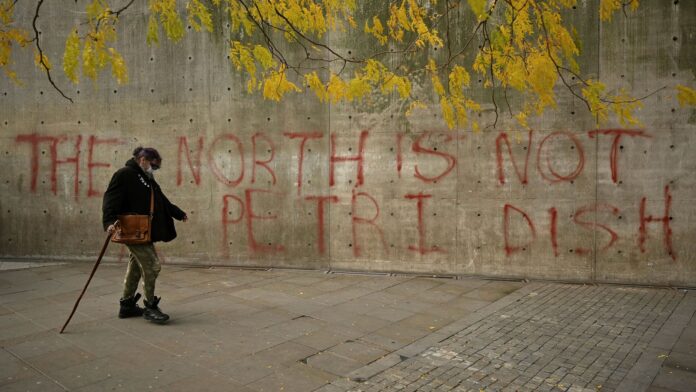A year on from the first government instructions to significantly limit social contact because of the coronavirus pandemic, The UK’s Office for National Statistics has looked at what the data tell us about these extraordinary 12 months and the way our lives have changed.
On 16 March 2020, people were told to work from home wherever possible while everyone was told to “avoid pubs, clubs, theatres and other such social venues”, to try to curb the spread of the coronavirus.
A week later, on 23 March 2020, the UK’s first lockdown would begin. From deaths and the pressure on hospitals, to the number of hours worked and people’s expectations of rising unemployment, we can see how the remarkable figures recorded over the past 12 months compare with others and made this a year like no other.
More than 140,000 people have now died in the UK with COVID-19 mentioned as the underlying cause or a contributory cause on their death certificates.
This includes more than 73,500 people in England and Wales whose deaths were due to COVID-19 — where it was the underlying cause — registered in 2020. Almost 4,400 further deaths from infectious and parasitic diseases were registered in 2020. COVID-19 is likely to be classed as an infectious and parasitic disease, following the precedent of similar diseases such as previous coronavirus strains (before COVID-19) and other viral infections.
This means COVID-19 was the underlying cause of more deaths in 2020 than any other infectious and parasitic diseases had caused in any year since 1918; that year there were just over 89,900 deaths from various infectious and parasitic diseases registered in England and Wales.
More recently, there were nearly 8,200 deaths from infectious and parasitic diseases in England and Wales in 2007. This coincided with a peak in deaths in England involving Clostridium difficile (C. difficile).
The number of adults in critical care in hospitals was far higher than previous winters.
Winter is usually the most pressured time in the NHS with the colder weather coinciding with an increase in illness and death.
However, the winter of 2020 and early 2021 was far from normal. Data from NHS England’s winter situation reports (SitReps), show that acute hospital trusts opened significantly more critical care beds, and that many more were occupied than in recent previous years, as hospitals reported greater pressure from the coronavirus (COVID-19).
In the last week of January 2021, more than 5,000 adult critical care beds a day were occupied in hospitals in England, compared with around 3,000 a day in the same week in 2020.
While the number of adults in critical care decreased in February 2021, it was still higher than any February over the previous decade.
Hospitals also opened significantly more critical care beds than in recent winters, ready to care for people suffering the severe effects of COVID-19. Between 20 January and 5 February 2021 there were more than 6,000 critical care beds open each day. Throughout January and February between 2017 and 2020, the number of critical care beds open ranged between 3,500 and just over 3,900.
With up to 8.9 million people on furlough and many businesses unable to trade as normal during lockdown, the average number of hours worked in the UK per person per week fell to 25.9 in April to June 2020, compared with 32.3 in the same three months of 2019. This was the lowest since January to March 2008, when average weekly working hours were 30.9 per person.
Accommodation and food services industries, which included people furloughed from closed pubs, hotels and restaurants, recorded a 54% fall in average weekly hours worked in April to June 2020, with 13.0 hours per worker on average compared with 28.4 in the same three months of 2019. Other industries saw less significant falls. For example, in financial, insurance and real estate services, where many workers were likely to be able to do so from home, the average in April to June 2020 was down 6% on the same period of 2019.
By October to December 2020, average weekly hours worked had increased but were still down by 7% overall on the same period of 2019, with accommodation and food services down 33% as they were affected by lockdown measures, the tier system in England and rules on the numbers of people allowed to meet indoors.
For many industries, the fall in job vacancies during 2020 was bigger than the 2008 economic downturn.
The Vacancy Survey shows that vacancies fell 38%, from 701,000 in January to March 2008 to a low of 432,000 in April to June 2009 before rising again.
In comparison, quarterly vacancies stood at 802,000 across the UK in October to December 2019 and fell by 57% to a low of 343,000 in April to June 2020, during the first lockdown. By October to December 2020, the number of vacancies had risen to 590,000, down 26% on the same three months of 2019.
Most industries recorded fewer vacancies in October to December 2020 than the same period the year before. In the accommodation and food service sector, which had been affected by lockdowns and social distancing, there were 29,000 vacancies in these three months, down 66% from 86,000 in the same three months of 2019.
Debt as a percentage of the economy has reached levels last seen in the early 1960s
From supporting the wages of furloughed workers to financial help for struggling businesses, the government has pumped significant funding into coronavirus support schemes. These, combined with reduced cash receipts and a fall in gross domestic product (GDP), pushed public sector net debt as a percentage of the economy to levels last seen in the early 1960s.
At the end of January 2021 public sector net debt (excluding public sector banks) was 97.9% of GDP.
The value of imports and exports fell more during the first three months of the pandemic than during the 2008 and 2009 economic downturn
The value of UK exports, excluding precious metals, fell by 22.5% year-on-year from £170.4 billion in the three months ending July 2019 to £132.1 billion in the same three months of 2020, while imports fell 26.1% from £176.8 billion to £130.7 billion.
This compared with an 8.8% year-on-year fall in the value of exports and 12.2% fall in the value of imports in the three months to July 2009 compared with the same three months of 2008, during the economic downturn. The data are in current prices and have not been adjusted for inflation.
Certain commodities also saw significant year-on-year falls in imports and exports following the start of the coronavirus (COVID-19) pandemic.
Fuel imports in the three months ending July 2020 were down by 58.5% on the equivalent period of 2019 followed by a 41.3% year-on-year fall in the three months to October 2020. Lockdown restrictions and other measures, such as advice to work from home, led to reduced transport use, with fewer people driving and needing to refuel their vehicles. As 2020 ended, fuel exports were still down 47.5% and imports down 26.5% year-on-year in the three months ending January 2021.
Exports and imports of machinery and transport equipment, which includes cars, vans and office equipment, were both down in the three months ending July 2020 (exports by 29.4% and imports by 27.9%) compared with the same three months of 2019, during the tightest restrictions. The easing of lockdown and subsequent increase in travel over the summer therefore contributed to the increase in exports and imports of machinery and transport equipment. Meanwhile, material manufactures, which include many metals and base materials — such as non-ferrous metals, iron, steel and goods manufactured using these items — saw only small falls in UK exports.
Fear of unemployment rose sharply while people’s expectations of their financial situation fell at its fastest rate on record
As more people reported their work had been affected by the pandemic, they also reported rising expectations for unemployment to increase, based on the scores in the Eurobarometer Consumer Survey (PDF, 137.8KB).
The largest month-on-month rise on record in people’s expectations for unemployment to increase was after March 2020, most of which was before the lockdown started. Expectations increased by 30 points (17.8 in March to 47.8 in April), followed by a further rise in May 2020 (49.4).
This meant that people’s expectations for unemployment to increase reached the highest level in over eight years. The previous highest was in January 2012 (49.6), which followed the peak of unemployment after the 2008 and 2009 economic downturn.
People’s expectations of their financial situation for the next 12 months fell at the fastest rate since records began, down from 1.5 in the month up to March 2020 to negative 9.9 in April 2020, but recovered slightly in May (negative 9.0). The rating was slightly more positive in December 2020 (2.9).
Overall, police recorded crime fell during the first lockdown but some offences saw an increase
Home Office data show police recorded crime in England and Wales was down by 19% with 1.25 million offences in the three months to June 2020 compared with 1.53 million in the same three months of 2019. Altogether the year ending September 2020 saw a 6% decrease in recorded crime on the previous year.
Despite the overall reduction during the first lockdown, some categories of offence in England and Wales saw an increase. There was a 32% rise in possession of drugs offences recorded in April to June 2020 compared with the same three months of 2019 and a 24% rise in trafficking of drugs. Recorded stalking and harassment offences increased by 20% from around 118,500 in April to June 2019 to around 142,000 in April to June 2020. They continued to rise in the three months to September, with around 163,000 offences, 31% up on around 125,000 recorded in July to September 2019.
Notable falls included a 74% drop year on year in recorded theft from the person in the three months to June 2020, a 47% drop in robberies and 51% drop in shoplifting. This coincided with the increase in time people spent at home during the lockdown period, reducing the opportunities for theft in public spaces and the closure of the night-time economy. Domestic burglaries were down 33% in the three months to June 2020, compared with the same period of 2019 and down 20% in the three months to September.







